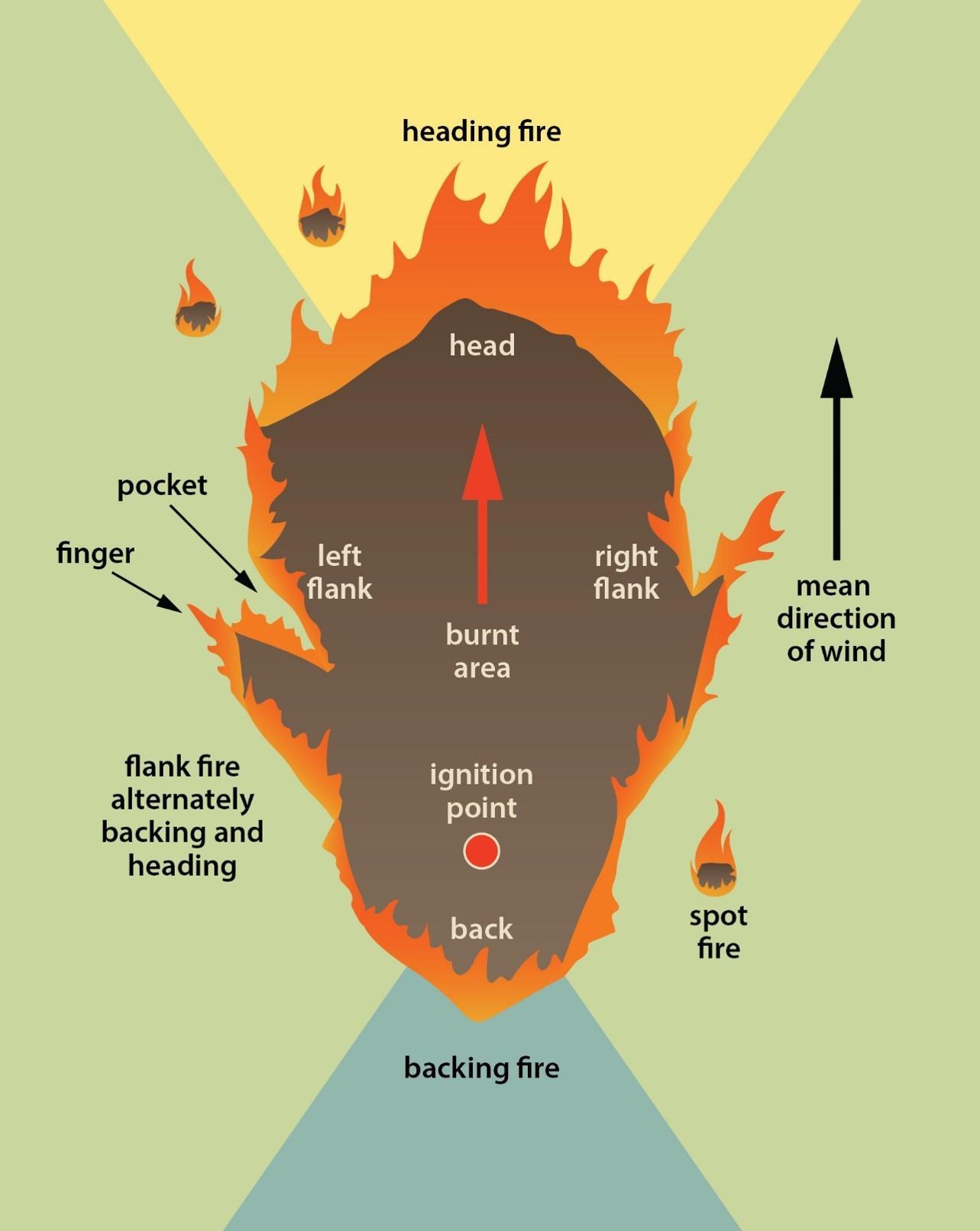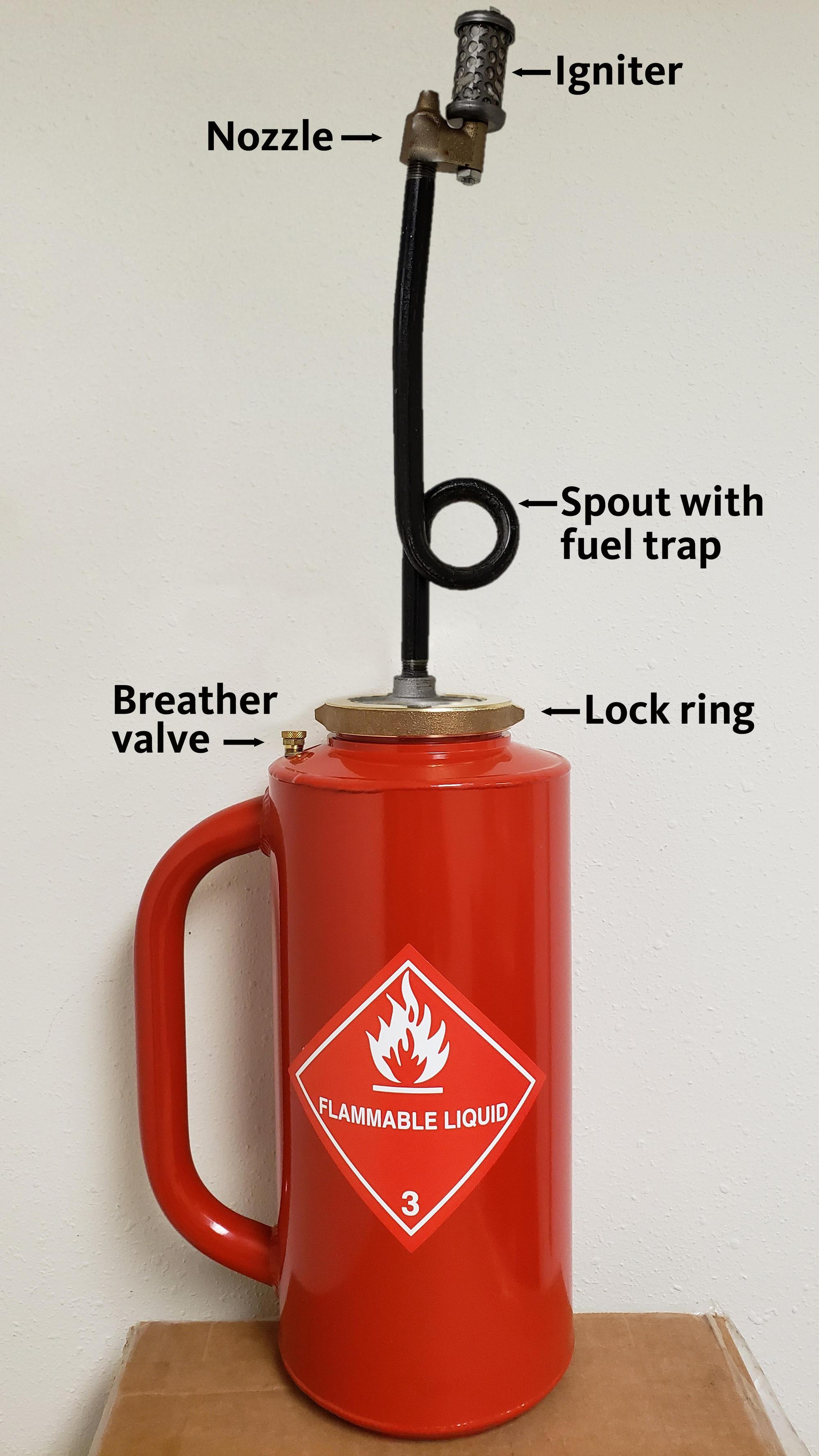On the day of the burn, prescribed fire managers rely on an in-depth burn plan. The burn plan includes the objectives of the burn and the steps needed to achieve them. Before putting fire on the ground, a few more steps are needed to ensure that everything is in place and everyone is informed. Once the burn begins, a variety of tools and tactics ensure the fire is conducted safely and achieves the desired outcome. After the flames have died down, mop-up and patrol wrap up a successful burn.
Before the burn begins
Before the start of a prescribed fire, burn managers ensure that all preparations have been successfully completed, everyone is properly informed and environmental conditions match the prescription defined in the burn plan. (See Planning a Prescribed Burn, EM 9343.) The first step is to go through the Go/no-go checklist, which lists the questions and conditions to assess before proceeding with the burn. This includes conducting a “size-up” of the planned burn area by evaluating the site and weather conditions to ensure that the unit is ready.
Pre-burn crew briefing
After the crew is assembled, the burn boss will hold a briefing to review each aspect of the prescription and the operational procedures for the day. The briefing covers topics outlined in the burn plan, including specific burn objectives, current and anticipated fuel and weather conditions, and safety considerations for everyone involved. The burn boss reviews the planned ignition patterns, methods and specific procedures based on the expected fire behavior. They will also identify potential problem areas, erratic fire behavior situations, and the forecast weather conditions. The burn boss conveys the plan for managing these elements to everyone participating and communicates holding and mop-up plans. Crew assignments are given and all the pertinent procedures highlighted for the day.
The meeting will prioritize safety, including identification of any known or anticipated hazards. Firefighters use a set of safety procedures known as LCES — Lookouts, Communication responsibilities, planned Escape routes, and constructed Safety zones. This briefing is an essential step that outlines the operations and intent for the day.
Notifications prior to burning
Once the team decides to proceed, a number of notifications may be necessary. It is important to ensure all the permits are in place and documentation accurate. Notification lists provided in the permits and on the burn plan will ensure each stakeholder has received the appropriate communication. These contacts include neighbors, local emergency services agencies, rural volunteer fire departments, the area Department of Forestry office, and other partners.
Test fires prior to the burn
The burn team conducts test fires before any ignition sequence takes place. These may be up to several acres in size. They occur in representative fuels and in a location that allows easy suppression if the team decides not to proceed with the burn. They are usually conducted on the downwind (or top of the slope) side of the burn unit to minimize spread in case fire behavior and smoke dispersal are not acceptable.
Test fires are usually conducted before relative humidity readings and fine fuel moisture levels hit their minimum values that typically occur in the early afternoon. If the weather is expected to be substantially warmer and drier later in the day, the behavior of a test fire may be much less intense than fire behavior that will occur later in the day. On the other hand, if test fire behavior is unacceptable in the morning, then it is a good indicator that fire behavior later in the day will probably be even more intense.
If the weather conditions, behavior of the fire and smoke dispersal meet the burn manager’s expectations, the prescribed burn can proceed. If the behavior of the test fire does not match expectations (either because the fire is too active or not active enough), the burn manager will call off the burn until better conditions arrive.
Igniting and holding the prescribed fire
Once the team decides to proceed with the burn, they can implement the ignition techniques outlined in the burn plan. An effective ignition method achieves the specific objectives of the overall burn plan. Burn bosses choose the appropriate ignition techniques that account for the burn objectives, fuel characteristics, pre- and post-burn weather, smoke management guidelines, adjacent fuels, available resources, staffing and equipment availability.
Fires behave based on their interaction with wind. Matching the flaming zone characteristics of fire spread to the appropriate ignition technique ensures that the burn will meet management objectives. A head fire is a flaming zone that moves with the wind or upslope in the absence of wind. A backing fire moves against the wind or downslope in the absence of wind. A flanking fire moves at right angles to the wind. During the ignition stage, the burn boss will observe the fire behavior and may alter the ignition patterns (by reducing the width of the ignited strip, for example, or adjusting the rate of ignition). This reduces the heat to keep flame lengths and rate of fire spread within the prescription. The team constantly watches how the smoke column develops and how the smoke moves in the area. As the burn progresses, the crew will periodically monitor weather conditions and make notations on the burn plan about weather and fire behavior.
This information is useful for understanding the fire effects on the resource after the burn is complete. The burn plan will consider changes that may occur after the fire has started.
Maintaining effective communications is crucial during a prescribed fire. Fire crews commonly use two-way radios to coordinate between teams, communicate potential hazards, convey unexpected weather changes, and share observations of erratic fire behavior. Using normal conversation in a calm manner during radio communications will help maintain a safe burn.
Ignition devices
Prescribed burn operations use the appropriate tools to conduct ignitions in a safe and effective manner. Anytime someone uses an ignition device, team members should wear full personal protective equipment, known as PPE, including fire-resistant clothing, long sleeves, eye protection, gloves, hard hats and leather boots.
The drip torch is the most commonly used hand-held ignition device. Drip torches are easy to maintain and have relatively few moving parts to repair. Drip torches use a mixture of diesel and gasoline combined at the proper ratio to achieve the burn objectives.
Crews may also use lighters, matches, fusees, or flares in light fuels such as grasses or when burning in rough topography. Propane torches are another option for burning relatively light fuels. These are fairly portable and can be worn on a backpack frame.
Holding activities
The holding crew, meanwhile, works to ensure the fire stays within control lines. They monitor for any situation where fire could potentially go outside the control lines of the burn unit, especially in the areas where the fire is actively burning.
Any spot fires outside the control lines are reported immediately to the burn boss and suppressed. Crew members can complete various tasks with their hand tools to cut wood, rake vegetation, dig control lines and smother flames.
Effective and consistent water delivery is key when needed on a prescribed burn. Water tenders and fire engines carry a large volume of water and can act as refill support for small mobile units. Additionally, smaller slip-on units that fit in the back of a pickup truck or small units mounted on or pulled by ATVs and UTVs are also useful in more challenging terrain. High-pressure, low-volume pumps are typically used to conserve water and aid with the suppression of the fire. Crew members can use 5-gallon backpack pumps. These versatile pumps can quickly deliver small amounts of water to suppress small flare-ups.
In the unlikely event a spot fire becomes established, the crew may begin suppression efforts and call-in additional resources as needed.
Mop-up and patrol of the prescribed burn
Mop-up refers to the extinguishing or removing of burning material to make sure the fire cannot spread outside of the established control lines and to reduce residual smoke. The prescribed burn crew will shift to mop-up after the ignition phase. This means patrolling along the burn unit perimeter to reduce flare-ups and knock down hot spots near the containment lines. During this time, crews expose the bottom of logs for hidden fire and hot embers. They feel the ground with their bare hands for subsurface hotspots, a process called cold trailing. Proper mop-up ensures any residual heat within the burn unit perimeter is reduced so the fire cannot flare up and spread across the fire lines. Many burn managers send crews to patrol partially burned islands of fuel within the unit boundaries and beyond the containment lines to ensure there are no residual hot spots. Crews may patrol for several days after the prescribed fire to ensure there is no potential for fire to spread.
Putting it all together
Careful and thorough planning of the burn before the burn is conducted ensures that the benefits of returning fire to the landscape are realized. Closely following the burn plan conditions on the day of the burn helps prescribed fire to meet the intended objectives, reduce impacts from smoke and maintain the safety of everyone involved. When conducted properly, prescribed fires can help managers safely and effectively restore the beneficial role of fire for the health and function of fire-dependent systems.
Resources
- Oklahoma Cooperative Extension. 2016. Prescribed Burn Equipment, Fact Sheet NREM-2899.
- Southern Fire Exchange Network. Ignition Devices for Prescribed Burning, SFE Fact Sheet 2013-3.
- U.S. Department of Agriculture. Introduction to Prescribed Fire in Southern Ecosystems, USDA-USFS SRS-054.
Acknowledgments
This publication is part of a series developed by the Forestry and Natural Resources Extension Fire Program. The program would like to acknowledge contributions from Chris Adlam, southwest regional fire specialist; Emily Jane Davis, Fire Program director and associate professor; and Daniel Leavell, Extension Forestry and Natural Resources faculty and associate professor of practice.




